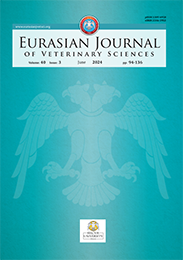| 2019, Cilt 35, Sayı 3, Sayfa(lar) 170-174 |
| [ Türkçe Özet ] [ PDF ] [ Benzer Makaleler ] |
| Isolation of dermatophytes from cats and dogs in Ankara |
| Bilge İşlek Selvi1, Murat Yıldırım2 |
| 1Kırıkkale Üniversitesi, Veteriner Fakültesi, Mikrobiyoloji Anabilim Dalı, Kırıkkale, Türkiye |
| Keywords: Zoonosis, Dermatophytosis, cats,dogs, isolation |
| Downloaded:1122 - Viewed: 3045 |
|
Aim: The aim of this study was to determine and identify
the dermatophytosis of hair samples taken from Mackenzie's
toothbrush technique from cats and dogs without any
symptoms in terms of dermatophytosis.
Materials and Methods: In our study, the whole body was scanned and hair samples were taken with totthbrush from a total of 120 animals, including 60 cats and 60 dogs. It was examined in light microscope using Potassium Hydroxide (KOH) for direct microscopy. After 3 weeks of incubation in Sabouraud dextrose agar (SDA) and Dermatophyte selective medium (DTM), colony morphologies were examined macroscopically. After that, microscopy was performed using lactophenol cotton blue and cellophane tape method. Results: Dermatophytosis agents were isolated and identified in 25.5% of dogs and 30% of cats in total in 27.5% of the samples. Cat and Dogs. Microsporum spp. (16%) was isolated from Trichophyton spp. (10.8%). When the findings were examined in terms of gender, 34.37% of female cats and 25% of male cats and 34.28% of male cats in female cats were isolated from dermatophytosis. Conclusion: It was observed that the potential transport of dermatophyte agent is frequently present in the skin and feathers of cats and dogs without any clinical findings. Due to the zoonotic character, it was concluded that it would be beneficial to inform the animal owners about this subject in close contact with cats and dogs. |
| [ Türkçe Özet ] [ PDF ] [ Benzer Makaleler ] |





